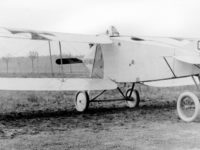The AEG C.III was a further development of the C.II and was intended to give the pilot a better view and the observer a better field of fire backwards and forwards. Despite these characteristics, the aircraft did not get beyond the status of the prototype.
Development and construction:
Usually the upper wing of biplanes was over the heads of the pilot and the observer. In the case of the AEG C.III, however, the upper wing was lowered and closed with the end of the fuselage so that a free field of view was created at the top.
This change in design was intended to give the pilot a much better field of view, and the observer who operated the machine gun should have a much better field of fire, and this attack could now be fended off from above.
Technically, this was a sensible solution, but this plane did not go beyond the status of the prototype and continued to be produced.
In the successor of the C.IV the upper wing was again mounted as usual over the heads of the crew.
Technical specifications:
| Designation: | AEG C.III |
| Country: | German Empire |
| Typ: | Armed reconnaissance aircraft (Prototype) |
| Length: | 7,09 meters |
| Span: | 11,85 meters |
| Height: | unknown |
| Mass: | 1.200kg with full charge |
| Crew: | Max. 2 |
| Engine: | Water-cooled, 6-cylinder in-line engine Benz Bz III with 150PS |
| Maximum speed: | 158 km/h |
| Reach: | unknown |
| Armament: | one 7.92 mm Parabellum machine gun, 40 kg bombs |
You can find the right literature here:
Fokker Dr I Aces of World War 1 (Aircraft of the Aces)
Undoubtedly the most famous fighter type to see service on either side during World War 1, the Fokker Dr I was a revelation when it entered service on the western front in 1917. Manfred von Richthofens JG 1 circus was the first Jasta to completely re-equip with the new fighter, and in the skilled hands of its numerous aces the Dr I proved a formidable opponent. The Dr I remained in service on the Western Front until replaced by the superior Fokker D VII in May 1918. Just weeks prior to that, however, Germanys leading ace, the great Red Baron, had been killed at the controls of a Dr I.
Friedrichshafen Aircraft of WWI: A Centennial Perspective on Great War Airplanes (Great War Aviation) (Volume 21)

Friedrichshafen Aircraft of WWI: A Centennial Perspective on Great War Airplanes (Great War Aviation) (Volume 21) Paperback – February 16, 2016
This book describes and illustrates the development of Friedrichshafen aircraft of WWI with text, 540 photos, 18 in color, 37 color profiles, production quantities and serial numbers of aircraft, and aircraft dimensions and performance specifications. In addition, there are 26 official SVK drawings and 11 aircraft are illustrated in scale drawings to 1/48 (4) or 1/72 (7) scales. The book has 312 pages and is of interest to aviation historians, enthusiasts, and modelers alike.
German and Austro-Hungarian Aircraft Manufacturers 1908-1918
Much has been written about the British aircraft of the First World War, but little has surfaced about the aircraft of the Axis powers, Germany and Austria. Here, Terry C. Treadwell tells the story of the aircraft from companies such as Fokker, builder of the famous triplane, as fl own by Baron von Richthofen's Flying Circus, AEG, Albatros, Junkers and Hansa. From reconnaissance aircraft to state-of-the-art bombers that could reach London, this is the definitive guide to aircraft of the Axis powers during the First World War. The aircraft are explained in detail and a history of each company is provided, making this an excellent source book for aircraft enthusiasts, model makers and those interested in the air war over the trenches of France and Belgium, as well as further afield in the Italian campaign.
The Zeppelin in Combat: A History of the German Naval Airship Division
The standard reference now revised and expanded. Dr. Robinson has opened up his vast photo archives to enhance this new edition of his classic work. Much of the new photographic material is published here for the first time.
This post is also available in:
 Deutsch (German)
Deutsch (German)  Français (French)
Français (French)  Italiano (Italian)
Italiano (Italian)  简体中文 (Chinese (Simplified))
简体中文 (Chinese (Simplified))  Русский (Russian)
Русский (Russian)  Español (Spanish)
Español (Spanish)  العربية (Arabic)
العربية (Arabic)














